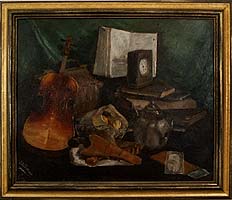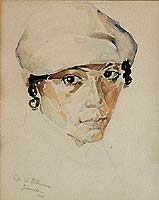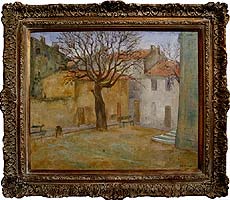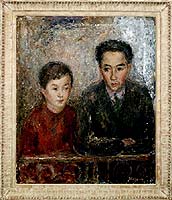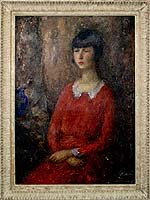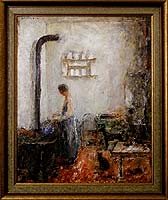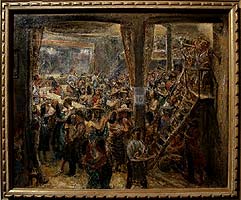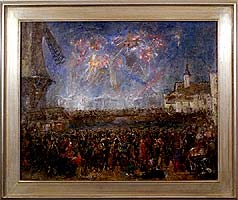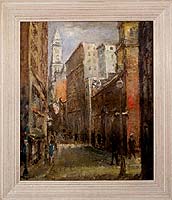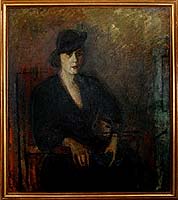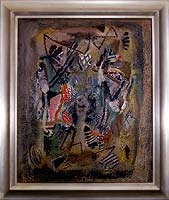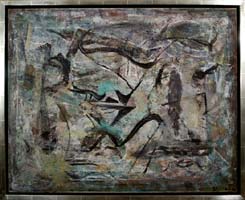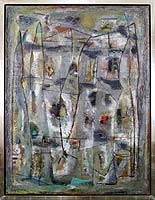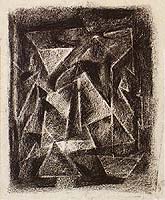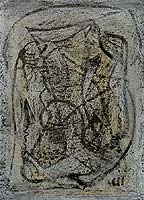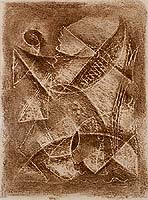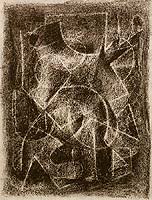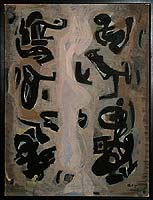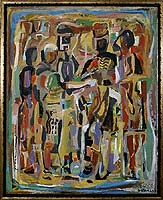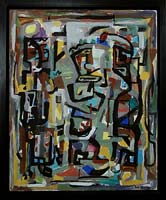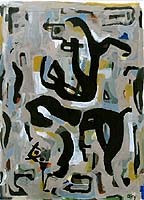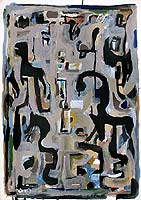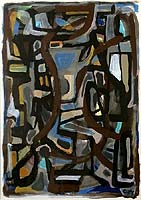
|
The Ary Stillman Green Room, Moores School |
|
T H E A R Y S T I L L M A N G R E E N R O O M Ary Stillman’s love for music inspired many of his greatest paintings. As an acknowledgment of this association, The Stillman-Lack Foundation and The University of Houston School of Music have dedicated the paintings within this page as a permanent part of the University's new music school, appropriately named "The Ary Stillman Green Room", these paintings will come to represent how beautiful music can indeed become works of art on canvas. A Life on Canvas, University of Houston, Moores School of Music, 1997
When the University of Houston held a small show of Ary Stillman paintings in 1964, Alfred Neumann who was at that time Dean of Arts and Sciences said to me, "Wouldn't it be wonderful if Ary's work could find a home here at the University?" I didn't think much about his remarks at the time because Ary and I had come to Houston partly because of family and partly because it was a way station to Mexico, a setting Ary particularly loved. However, as the years rolled on and Ary's health diminished, Houston took on a more important role in our lives and in our planning for the future. Thus, when David Tomatz, Director of the University of Houston School of Music, asked to house a significant number of Ary's paintings in the new music building's Green Room to be known as the Ary Stillman Room, the response was affirmative without any hesitation. Houston was now home. Ary had loved music almost as much as painting, and our niece, violinist Fredell Lack Eichhorn, was a devoted and leading participant in the University's musical life. Although the Ary Stillman Room does not house the entire Stillman collection, it is currently the largest retrospective of his work on public display and embodies some of the finest examples of each period of his long and fruitful life. And because many visitors to this room are being introduced to Ary Stillman for the first time, this booklet draws on three sources to introduce them. One source is from critics who reviewed some of the paintings when they first appeared in major exhibitions in years past. A second source is from direct quotes of the artist, which were published, in a small brochure by the Stillman-Lack Foundation formed shortly after the artist's death. Finally, there are excerpts from Reminiscences, a private printing on Ary's life and observations, which he and I wrote individually and together. It is our hope that this introduction to the artist will inspire the new viewer to learn more about the creative and mystical world of Ary Stillman. Frances Fribourg Stillman
Many places served as home for Ary Stillman during his long and eventful lifetime. There was the tiny village in White Russia where as a youngster he fulfilled a vague longing by cutting out designs from rough paper and filling them in with colors—a collage. There was the midwestern town in the United States (Sioux City, Iowa) where the immigrant lad toiled by day to support himself, his mother, sister and brothers, and then by night set up an easel and painted portraits and still-lifes. There was Paris in the legendary '20s and '30s where aflame with the beauty of his surroundings he produced poetic and sensuously rich canvasses acclaimed by Paris critics. There was New York City where he played a leading role in the art scene of the '30s, '40s, and early '50s, with a steady succession of one-man exhibitions and group showings. Then, in the last decade of his life, there were five years in Mexico and an equal number in Houston. Mexico followed a period of declining health, an eye injury, the loss of his longtime studio in New York, and a futile search for a suitable setting in Paris. He had spent a happy six months in Mexico in 1940—perhaps it could work its magic on him again. And indeed, the beauty and peace of Cuernavaca worked magic on him. Gradually his health improved, and a whole new series of exotic fantasies came forth "the culmination of his artistic career," many critics said. But by 1962 ill health plagued Stillman to such an extent that he felt impelled to seek the loving care of his family and friends in Houston, Texas. He continued working during those years, but at an increasingly slower pace. During his final years, the University of Houston persuaded him to have an exhibition at their temporary art gallery. Dr. Peter Guenther wrote of that exhibition: "Mastery of the medium, sensitivity and the quiet, strong determination to permit the inner reality to find its expression in a modern and very personal form, marks the works of Ary Stillman exhibited here for the first time in Houston. Although the selection given here spans more years than the average age of our students, it is only a small part of the painter's creative horizon. The exhibition is therefore not a retrospective one and no viewer need impose a historical attitude on himself but may permit these works to span the gap between the knowledge of the today and the experience and wisdom of ages-long-past through images which a painter's heart and mind have gathered and gained through the years."
Music was Ary's love, after painting. He was an avid concert goer, and in his New York studio he always had the radio tuned to the music stations as he worked. He didn't know one note from another, but he usually could recognize any composer he had heard to any extent. I found it interesting to note the reviews in which his paintings were compared to music. Of course the paintings mentioned were named simply for exhibition purposes, since the public likes a title. Ary never consciously tried to translate music into painting. However, he would often say to people who were seeking some explanation of his abstractions, "Look at them the way you listen to music." In other words, don't seek a literary connotation; this is an abstract art like music. The following are quotes from critics who wrote for various New York publications: "These new compositions bear a direct relation to music and might appropriately be called tone poems. A number of them are on Indian themes, including the large Indian Legend, with shimmering water suggested in the foreground, moving back and around, but always within the picture frame." The Art Digest "... a style dominated by a new lyric use of color and aiming at suggestion rather than representation. Paintings on Indian themes remind one of music as for example, Sibelius suggests an old tribal war mood in 'Saga.'" New York Times "...I use colors like a composer uses musical notes,' he says, and although he has no actual system of color-and-sound counterparts, as some extreme theorists have attempted, Stillman's paintings do remind one of the emotional overtones of certain musical compositions." Pictures on Exhibit "...Some titles, such as 'Jazz,' indicate that certain ones have been inspired by hearing music..." New York Times "Ary Stillman's current exhibition asserts again how well an abstract style can serve lyrical statement and enrich the evocative image . . . Musical themes inspire these paintings, and without descending to trite analogies, they successfully translate the intangibles of one art form into another. Overture, for example, captures the rising sense of promising beginnings that such a musical composition can offer..." The Art Digest "...Designed, for the most part, on musical themes (some of his titles are "Obligato," Overture," and "Jazz,") the handsome new canvases are rhythmical in pattern, so composed that the well defined shapes hold together in, almost, magnetic fashion." New York Herald Tribune "…the rippling cadences with which he defines a mass of form eliciting a sensation of movement..." New York Herald Tribune "...Stillman's linear patterns always have been decidedly musical. This year they are choppier than last, as if he had been listening to Bartok instead of Debussy." James Fitzimmons of Art Digest "On the other hand, Ary Stillman's paintings at the Bertha Schaefer Gallery carry abstraction deep into its 'romantic' phase. For him, plastic rhythms are a means of evoking poetic content. Color, refulgent and suggestive, stirs the visual imagination to respond to something beyond the world of pure shapes. Texture and technique are also used to this end…" New York Times
"...Ary Stillman was always a master painter. Of course, one realizes that he did not emerge fully armed from the brow of Zeus as did Athena, that there were periods of study which led to mastery, and other early periods when necessity forced an abandonment of painting, but the dedication to it was never lost and the technical mastery which gave meaning was ever present." James Chillman, Jr.
Then began for Ary what undoubtedly was the happiest
period of his life. He was madly in love with Paris†with her beauty,
her spirit, her language, her art. Here was ambiance in which
he felt entirely at home. There was a subtly, a refinement, a
delicacy, a "bon gout" which set every fiber of his being to vibrating.
He was suddenly set free from all bonds, which had been shackling
him all those years in Sioux City.
New York City "When Ary Stillman returned to New York in 1933, he came as an established painter. His paintings were still representational but with a subjectivity, which continued to mark his works. He dealt with scenes of the streets, the market places and the parks where the rush of humanity is always visible. But he treated them with a distinctly personal approach, in which the impact to the viewer came from the thoughts and inner feelings of the artist rather than from descriptive realism." James Chillman, Jr.
New York City Ary's painting had undergone a radical change. This had been brewing ever since the early part of World War II. Ary was, of course, profoundly shaken by the war, by the enormity and brutality and hideousness of it, and especially by the tragic fate of six million Jews. He was in an emotional upheaval that affected every phase of his being, and of course this included walks we would take in Central Park on Sunday afternoons; we would wind up in some secluded spot and then Ary would give voice to his thoughts and feelings. He would say, "I cannot continue to paint the way I have been doing, I am sure that every creative person will have to make some change. For me, the world of surface realities is no longer paintable. For nothing is as it formerly seemed. It is not the surface of things—the look of things—that is real—it is that which is hidden beneath the surface—an inner reality of some sort that is real. And that is what I must search for. I can no longer set up a still-life, or paint the view of a city street, no matter how much of my own perception and sensitivity I put into the painting. I shall have to dig down deep within myself—back to my subconscious, if possible—and bring out what will be an inner reality." Pg. 81, Reminiscences
We read everything on pre-Cortez times that we could find. Prescott's history of the conquest of Mexico and Peru; Bernal diaz del Castillo, who described so quaintly and so graphically the country and the people and the details of the coming of the Spaniards, as one of Cortez' men; more recent writers on the culture of the Aztecs, the Mayans, the Incas. Also general mythology such as the Golden Bough, poetry such as The White Pony, an anthology of Chinese poetry from 1.100 B.C. through 1921. All this fired Ary's imagination, and what with improved physical condition, greater peace of mind, and new stimuli to inspire him, Ary's incredibly rich imagination began to reassert itself. Now, he fantasized, he had discovered through excavating among ancient ruins, a "palace of the prince" and everything that poured forth as he sat in the armchair in the corner of the verandah was something he carried away from the walls of this ancient palace. So in 1960 he began a series of gouaches, which in creativeness, in spontaneity, in line and form are perhaps the culmination, or at least the beginning of the culmination of his entire career as a non-representational painter. Ary felt that himself, "I am a new Ary" he would say. He even decided that this new Ary should have his name on the paintings rather than the old Stillman whose depression he had fought off. So one will find that practically all of the gouaches and many of the later canvases bear the name Ary. Later on, after we left Mexico, he drifted back into signing Stillman again. Frances Stillman
|
|||||||||||||||||||||||||||||||||||||||||||||||
| © 2008 The Stillman-Lack Foundation, All text and images on this site may not be published, broadcast, or distributed in any form without the prior written permission of The Stillman-Lack Foundation. |
